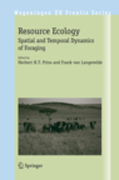
Resource ecology: spatial and temporal dynamics of foraging
Prins, H.H.
Langevelde, F. van
This multi-author book deals with ‘resource ecology’, which is the ecology oftrophic interactions between consumers and their resources. Resource ecology is perhaps the most central part of ecology. In its linkage between foraging theory and spatial ecology, it shows how old and fundamental questions can be tackled afresh. It addresses crucial aspects of the interactions between consumers and resources. Foraging is the central process in resource ecology becauseit leads to growth, survival and reproduction of the animal. Resource ecologyforms the basis for comprehending the functioning of multi-species assemblages, and is thus key to grasp the organisation of biodiversity. All chapters in the book were prepared for a small symposium and were circulated in advance tothe participants. They were subjected to intense group discussions; comments and critiques were subsequently used for writing new versions, which were peer-reviewed. Coherent set of chapters dealing with resource ecology (ideal for lecturers developing a new course on resource ecology). Every chapter has testable hypotheses for further research (ideal for students, especially PhD students looking for good subjects for their theses). Ample attention for the emerging issue in ecology of ‘scale’ INDICE: Preface. 1. Introduction on resource ecology. 2A. Mechanisms determining large-herbivore distribution. 3A. Spatial statistics to quantify patterns of herd dispersion in a savanna herbivore community. 4A. Resource distribution and dynamics: mapping herbivore resources. 5A. Foraging in a heterogeneousenvironment: intake and diet choice. 6A. Predictive modelling of patch use byterrestrial herbivores. 7A. Assembling a diet from different places. 8A. Effects of temporal variability in resources on foraging behaviour. 9A. Large-scale movements of large herbivores: livestock following changes in seasonal forage supply. 10A. Relevance of key resource areas for large-scale movements of livestock. 11A. Structuring herbivore communities: the role of habitat and diet.12. Prospects for further development of resource ecology. List of references. List of contributors.
- ISBN: 978-1-4020-6849-2
- Editorial: Springer
- Encuadernacion: Rústica
- Páginas: 306
- Fecha Publicación: 01/01/2008
- Nº Volúmenes: 1
- Idioma: Inglés
